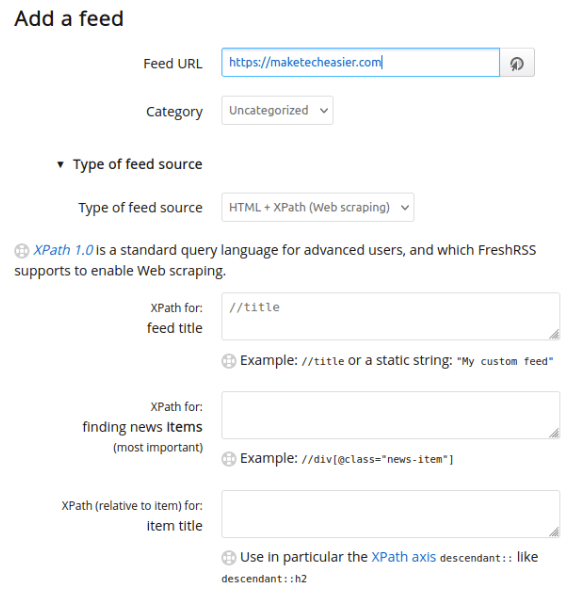
FreshRSS is a simple and easy to deploy web-based RSS feed reader for Linux servers. Similar to Tiny Tiny RSS, it works by providing a clean, cross-platform interface that you can access from your web browser.
This article will show you how to install FreshRSS on Ubuntu. We will also highlight how you can configure the reader for a multi-user session.
Why FreshRSS?
One of the biggest selling points of FreshRSS is that it comes with a built-in web scraper. This means that you can create basic RSS feeds even on websites that do not support it.

FreshRSS also supports push notifications on modern content platforms. As a result, the platform can be incredibly quick and reactive to post updates. Lastly, it is also simple to install which makes it an ideal project for novice users that are just getting started with self-hosting.

Installing FreshRSS
Assumption: This article assumes that you have a working domain name with an A and PTR record pointing to your VPS instance’s IP address and hostname.
We will be using Docker to install FreshRSS.
Install Docker
Fetch the Docker repository’s signing key from the project’s website:
curl -fsSL https://download.docker.com/linux/ubuntu/gpg | sudo gpg --dearmor -o /etc/apt/keyrings/docker.gpg sudo chmod a+r /etc/apt/keyrings/docker.gpg
Create a new repository file for Docker:
sudo nano /etc/apt/sources.list.d/docker.list
Write the following line of code inside your new repository file:
deb [arch=amd64 signed-by=/etc/apt/keyrings/docker.gpg] https://download.docker.com/linux/ubuntu jammy stable
Refresh your system repositories, update your system, and install the Docker binaries:
sudo apt update && sudo apt upgrade sudo apt install docker-ce docker-ce-cli containerd.io docker-compose-plugin docker-buildx-plugin nginx
Building the FreshRSS Docker Container
Make a new directory in your user’s home directory for FreshRSS and go inside it:
mkdir ~/freshrss && cd ~/freshrss
Create a “docker-compose.yml” file using your favorite text editor:
nano ./docker-compose.yml
Paste the following block of code inside your new docker-compose file:
--- version: "2.4" volumes: data: null extensions: null services: freshrss: image: freshrss/freshrss:latest build: context: https://github.com/FreshRSS/FreshRSS.git#latest dockerfile: Docker/Dockerfile-Alpine container_name: freshrss hostname: freshrss restart: unless-stopped logging: options: max-size: 10m volumes: - data:/var/www/FreshRSS/data - extensions:/var/www/FreshRSS/extensions ports: - "8080:80" environment: TZ: Asia/Manila # CHANGE TO YOUR TIMEZONE CRON_MIN: 3,33
Save your docker-compose.yml file. Run the following command the build your docker container:
sudo docker compose up -d
Setting Up Reverse Proxy and SSL
Once the FreshRSS instance is up and running, next we will configure Nginx to d a reverse proxy so you can access it publicly via your domain name.
To start, create an Nginx site configuration file for your instance:
sudo nano /etc/nginx/sites-available/freshrss
Paste the following block of code inside your new site configuration file:
server { listen 80; listen [::]:80; root /var/www/html; server_name freshrss.your-domain-name.here; location / { proxy_set_header X-Forwarded-For $remote_addr; proxy_set_header Host $http_host; proxy_set_header X-Forwarded-Proto $scheme; proxy_pass http://localhost:8080; } }
Save your new site configuration file and run the following command to create a symbolic link to “/etc/nginx/sites-enabled”:
sudo ln -s /etc/nginx/sites-available/freshrss /etc/nginx/sites-enabled/
Test your Nginx configuration:
sudo nginx -t
If everything is fine, reload your Nginx server daemon and enabling it on system startup:
sudo systemctl reload nginxEnabling SSL For Your Instance
To obtain an SSL certificate, install the core snap daemon to your system:
sudo snap install core
Fetch and install the Electronic Frontier Foundation’s (EFF) certbot utility using snap:
sudo snap install certbot --classic
Register your certbot installation to the EFF by running the following command:
sudo certbot register --agree-tos -m you@your-email.invalid
Request an SSL certificate for your instance by running the following command:
sudo certbot --nginx -d your-freshrss-domain-name
Accessing and Configuring FreshRSS
Open a web browser and navigate to the address of your new FreshRSS instance. Click the dropdown list on the page and select the language that you want FreshRSS to run on, then click “Submit.”

Doing that will load FreshRSS’ self-test module which will check whether the current instance is running properly. To continue, scroll down to the bottom of the page, then click “Go to the next step.”

Click the dropdown list, select “SQLite” then click “Submit.”

Fill in the details of your instance’s administrator user, then click “Submit” to create it.

Click “Complete installation” to properly start your new FreshRSS instance.
Enabling User Registration
To start, login to your FreshRSS administrator account, then click the cog icon on the page’s upper right corner.

Scroll to the “Administration” category, then select “System configuration.”
Go to the “User registration form” subcategory, click the dropdown box beside the “Registration form”, then select the “Enabled: No limit of accounts.” option.

Save your new site configuration by clicking the “Submit” button on the bottom of the page.
Wiping an Existing User’s Data
Go to your FreshRSS administrator account, then click the cog icon on the page’s upper right corner.
Go to the “Administration” category, then select “Manage users.”

This will bring up a page with a list of the current users in your FreshRSS instance. Click the name of the user that you want to disable.

Click the “Purge” button to wipe the user’s RSS feeds clean.

Hosting your own web-based RSS feed reader is just the start of taking over your personal data online. Learn how you can host your own video sharing website with Peertube.
Image credit: Yongma Seo via Unsplash and FreshRSS Github (Logo). All alterations and screenshots by Ramces Red.
Our latest tutorials delivered straight to your inbox